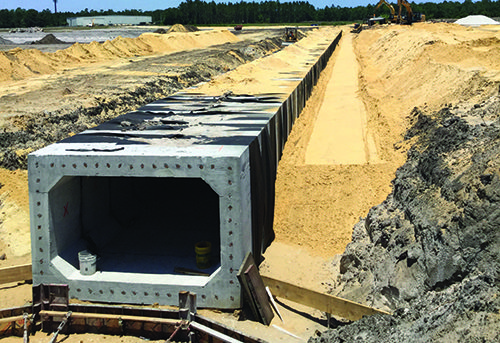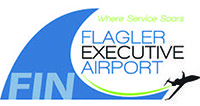Flagler Executive Airport (FIN) in Palm Coast, FL, recently completed a $12.2 million project to relocate and extend its main runway. In doing so, management remedied several safety issues in one comprehensive construction program.
Flagler Executive Airport (FIN) in Palm Coast, FL, recently completed a $12.2 million project to relocate and extend its main runway. In doing so, management remedied several safety issues in one comprehensive construction program.
 Airport Director Roy Sieger refers to FIN’s new runway as its “crown jewel,” and notes that the project was completed under budget and ahead of schedule. The project was the airport’s largest construction initiative since FIN was built in 1942.
Airport Director Roy Sieger refers to FIN’s new runway as its “crown jewel,” and notes that the project was completed under budget and ahead of schedule. The project was the airport’s largest construction initiative since FIN was built in 1942.
One of the issues corrected by the Runway 11-29 project was a runway/runway intersection hotspot. “The runways intersected right at their thresholds, which was really confusing to pilots,” Sieger explains. The original runway also had safety areas that did not meet the minimum FAA standards as well as inadequate runway/taxiway centerline separation to accommodate the increase from Runway Design Group (RDG) II to RDG III. This separation issue, along with property restrictions and restrictions to future development, drove the need to relocate the runway from its original location.
|
Project: Runway Extension & Relocation Location: Flagler Executive Airport (Palm Coast, FL)Runway 11-29 Cost: $12.2 million Funding: FAA 74%; FL Dept. of Transportation 24%; Airport 2% Notice to Proceed: Feb. 6, 2017 Substantial Completion: Dec.15, 2017 Contract End Date: Jan. 27, 2018
Full Airport Closures: 3 nights Resident Engineering Services & Construction Management: GAI Consultants; Hoyle, Tanner & Associates
Environmental Mitigation: Environmental General Contractor: Halifax Paving Design: C&S Companies
Drainage Sub-Contractor (Box Culvert): Electrical Subcontractor: H.L. Pruitt Corp. Runway & Taxiway Light Mfg: Astronics Runway End Identifier Light Mfg: Astronics Runway & Taxiway Sign Mfg: ADB Safegate |
The runway was relocated 400 feet south of its original position and the original runway was reconstructed as a full parallel taxiway. The runway was shifted to the east and extended 501 feet on the east end on the runway, for a new overall length of 5,500 feet. Other project elements included new LED runway and taxiway lighting, new LED guidance signage, new LED runway end identifier lights and drainage improvements.
The new asphalt runway was paved with six 17.5-foot-wide paving lanes. Each lane was paved from end of blast pad to end of blast, creating a finished product free of transverse pavement joints. Having no transverse joints helps prevent cracking, requires less maintenance and provides a smoother ride for aircraft, notes Sieger. This method also accelerated the paving process, as crews were able to place significant tonnage each day. During construction, the original runway remained open for use to minimize operational disruptions.
The FAA contributed $9.3 million in grant funding and Florida Department of Transportation contributed nearly $2.7 million in grant funding toward construction of this project. Flagler County paid the remaining balance, mainly by using funds generated by the operation of the airport.
The new and improved runway enables FIN to handle a larger volume of air traffic and eliminates prior safety concerns. The longer runway also allows corporate jets to take on more fuel when flying out of FIN, thus increasing revenue potential.
Preliminary Projects
Before breaking ground on the runway relocation and extension, FIN completed roughly $5 million in preliminary projects. In addition to performing traditional site prep, airport officials needed to acquire additional land to meet FAA runway protection zone standards. In the end, FIN purchased 117 acres of land from a private owner for $1.9 million.
On the environmental mitigation front, personnel from Environmental Science Associates excavated 250 gopher tortoise burrows and relocated 70 gopher tortoises to a local receiving bank.
Planning was also a major prerequisite of the project and central to its success. Designs for the Runway 11-29 project were part of a master plan developed in 2003.

Massive Undertaking
Construction began early February 2017 and was completed by mid-December the same year. The original Runway 11-29 was decommissioned after Sieger and pilot John Rising performed a final ceremonial takeoff in a T-6 Texan. “The asphalt machine followed right behind us,” Sieger muses.
He highlights the installation of a box culvert as a particularly noteworthy accomplishment. In just 10 weeks, crews completed the dewatering and installation of bypass pipes; dammed and drained the existing canal; backfilled the canal with imported material; and installed, inspected and commissioned the culvert for use. The new structure is a 734-foot-long, 10-by-6-foot precast concrete box culvert with cast-in-place concrete headwalls and wingwalls. Each of the structure’s 162 precast concrete sections is 4½ feet long, with 14-inch thick walls. Each of the 30,000-pound sections was individually delivered to the site and set in place by a 400-ton excavator. On average, crews placed 10 sections per day. After all the precast sections were in place, inspected and approved, crews completed the cast-in-place headwalls and wingwalls.
The overall runway project required the excavation of 340,000 cubic yards of material. During a critical 50-day phase of the project, crews worked 24 hours per day for the first seven days to move 150,000 cubic yards of material on site. During this critical 50-day phase, an average of 50 workers were on site at any given time working on all aspects of the project to keep the work on schedule.
Despite the scope of the project, FIN experienced minimal impact to air traffic, and the airport was closed just three nights for grooving and pavement markings. “We still maintained a high level of operations,” Sieger reports.
Veteran Team
 Dan Nickols, the resident engineer from GAI Consultants who managed the project, had worked with Halifax Paving on three previous taxiway projects at FIN. The shared work history helped develop a good rapport, promoted effective communication and ultimately contributed to the success of the Runway 11-29 project, says Sieger.
Dan Nickols, the resident engineer from GAI Consultants who managed the project, had worked with Halifax Paving on three previous taxiway projects at FIN. The shared work history helped develop a good rapport, promoted effective communication and ultimately contributed to the success of the Runway 11-29 project, says Sieger.
 Jack Thompson, GAI’s Florida director of aviation, notes that having Nickols on site each day as resident engineer was also key. Nickols’ knowledge of the design intent made him an invaluable resource, Thompson explains. Scott Croll of Halifax Paving agrees, describing Nickols’ presence on site as extremely helpful.
Jack Thompson, GAI’s Florida director of aviation, notes that having Nickols on site each day as resident engineer was also key. Nickols’ knowledge of the design intent made him an invaluable resource, Thompson explains. Scott Croll of Halifax Paving agrees, describing Nickols’ presence on site as extremely helpful.
Like Nickols, Croll had years of work history with the airport and was on site every day. During this project, his crews set and subsequently broke company records for 2-inch asphalt paving in a single work day: 3,610 tons and 3,612 tons on successive days. The company also recorded perfect pay factor test results: all percent within limit specifications (PWLs) for quality and consistency were 90% or higher.
 “I assembled a great team, a very cohesive team, that was able to get a lot done in little time,” Sieger says. The team held weekly meetings to help foster a culture that pushed the project ahead of schedule. “We always had a good two-week look ahead, and they were on track all the time,” he recalls.
“I assembled a great team, a very cohesive team, that was able to get a lot done in little time,” Sieger says. The team held weekly meetings to help foster a culture that pushed the project ahead of schedule. “We always had a good two-week look ahead, and they were on track all the time,” he recalls.
Weather conditions during the project were a mixed bag. The first half of 2017 was unseasonable dry by Florida standards, but Flagler County received 72 inches of rain by the end of the year—its largest recorded annual total. The elevated rainfall total was the result of an active hurricane season and the landfall of Hurricane Irma, which shut the project down for five days. Despite heavy rainfall in the latter part of the year, and the aftermath of Irma, crews still completed the project under budget and ahead of schedule.


 facts&figures
facts&figures

